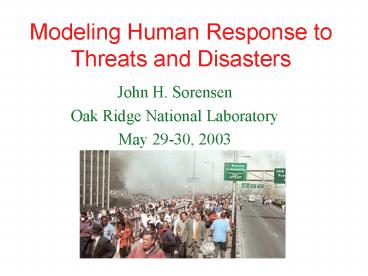Modeling Human Response to Threats and Disasters - PowerPoint PPT Presentation
Title:
Modeling Human Response to Threats and Disasters
Description:
Seek protective shelter/ stay home/ isolation. Respiratory protection. Decontaminate ... Run Evacuation and Shelter Models. System components to be tested are ... – PowerPoint PPT presentation
Number of Views:24
Avg rating:3.0/5.0
Title: Modeling Human Response to Threats and Disasters
1
Modeling Human Response to Threats and Disasters
- John H. Sorensen
- Oak Ridge National Laboratory
- May 29-30, 2003
2
Major Modeling Thrusts in Disaster Research
- Warning Response
- Warning Diffusion
- Evacuation Behavior
- Protective Action Effectiveness
- Psycho-Social Impacts
- Intelligent Consequence Management
3
Warning Response Research
- Started in the 1950s
- Driven by the shadow of nuclear war
- If we sound the sirens, what will people do?
- Series of studies - tornado, hurricane, flood,
explosion, air raid sirens, alien invasions - Major findings
- People seek more information
- People converge on event
4
Warning Response Process
Hear
Understand
Believe
Personalize
Confirm
Respond
5
Factors Increasing Response
- Receiver Characteristics
- Visual and other cues
- Family and network
- Female
- Younger
- Majority
- High SES
- Non-fatalistic
- Sender Characteristic
- Message source
- Message channel
- Message style
- Clear
- Specific
- Accuracy
- Certain
- Consistency
- Message Content
6
Alternative Responses to Natural and
Technological Hazards
- Do nothing/ denial
- Confirm warning/ seek information
- Evacuate/ temporary relocation
- Seek protective shelter/ stay home/ isolation
- Respiratory protection
- Decontaminate
- Seek medical attention
- Help others
7
Modeling Diffusion of Warning
8
(No Transcript)
9
(No Transcript)
10
(No Transcript)
11
(No Transcript)
12
Intelligent Consequence Management
- New sensor networks or links to existing sensor
networks designed to detect and monitor the
threats of concern - High-speed communications and data exchange
- Real-time simulation models running on high-speed
machines - Faster than real-time predictive capabilities
- Advanced decision support tools that can process
data and simulation outputs into a format useful
to decision-makers
13
ORNL LDRD
- Dynamic evacuation modeling
- Utilize deployable road sensor tape or existing
monitors - First evacuation model with dynamic traffic
assignment - Can update simulations using real time data
- Linked to GIS
14
Intelligent Consequence Management Architecture
for Rad/Chemical Incident
Alerting Sensor
Sound Preparedness Alert
Protective Action Library
Protection Action ES
Notify Emergency Response Team
Damage Assessment
Activate Monitors
Choose Protection Plan
Evacuate
Go To Safe Room
Dispersion Scenario Library
Run Economic Model
Data Archive
Generate Evacuation Plan
Generate Evacuation To Safe Room Plan
Run Evacuation and Shelter Models
Outdoor Dispersion Model
Classify Event
Distribute Plans (Electronically)
Activate Warning With Evacuation Instructions
Accident Library
Data Archive
Send Data
Distribute to Emergency Response Team
RT Traffic Counters
Send in Response Team
Activate Field Monitoring
Generate Emergency Response Plan
Generate Sampling Plans
Initiate Search Response Initiate
Sampling Initiate Decontamination
System components to be tested are in red
Generate Search Rescue Plan
15
Major Questions
- How will warnings be issued to publics once a bio
event is identified? - To what degree will human behavior in a bio event
be similar to other hazards? - Will bio events elicit a different types of human
response than observed for other hazards? - What are the relevant parameters to model in a
bio event?































